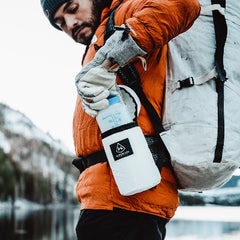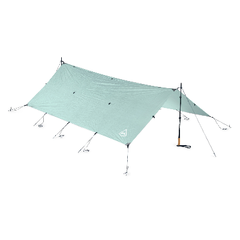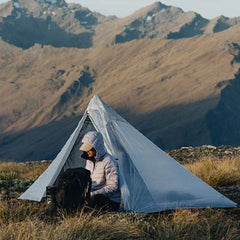Hyperlite Mountain Gear Ambassador Kurt Ross recently returned from a mega-successful climbing adventure to the Kahiltna Glacier, Denali National Park, Alaska. Please see Part I to read an overview of the five routes he climbed. Below is his personal report of climbing The French Route on Mount Hunter.
Words & Photos by Kurt Ross
I rappelled to the end of our ropes, slammed in a couple of screws, and yelled, “I’m off!” to my climbing partner, J.D. Merritt. While I threaded our next rappel, the rope didn’t move. I screamed a few more times, pulled aggressively on the lines, then gave up. I slumped onto the slings attaching me to the face and dozed off, as I had done at every other moment where my wakefulness couldn’t help our progress. I was happy for the opportunity to take weight off my feet. Keeping them sealed in soggy boots for the past few days waterlogged my skin, making them feel blistered all over. After an indeterminate amount of time, J.D. buzzed down the rope and we continued.
Somehow, after three full days on the go with only a couple hours of rest, we didn’t feel out of control. Of course we were extremely tired, but we could still think clearly enough to problem solve our way through the terrain. It’s scary to think about how we would have dealt with a bad storm or messy fall, but pushing ourselves this far didn’t feel reckless in the situation as it was.
We were descending the West Ridge of Mt. Hunter after climbing the Garison-Tedeschi (A.K.A. French Route) on the North Buttress of the mountain, a route Mark Westman calls, “the proudest and most intimidating line on the wall.” We decided to try The French Route instead of any other one because we figured it might be more intact than any other line on the face after the long spell of warm temperatures that we’d had on the Kahiltna. The hard-man Slovenians, Luka Lindic and Ales Cesen, also encouraged us; they had climbed the route to the top of the buttress a couple weeks prior. The only real beta we had on route was the finger-point directions that duo had sprayed at us in base camp.

At around 11p.m. on a day in late May we skied out of camp toward the beautiful and intimidating face. At the top of “ski hill,” J.D. mentioned, “I’m not nervous because I think we can’t do it, but because I think we can.” I agreed. We stashed our ski boots and planks at the base, then went into business mode.
J.D. made short work of the bergschrund, then gave me a quick belay across. We simul-climbed through the traversing ice and snow, which led to the base of the prominent gully that aesthetically defines the route. I led a shorter simul-block, then we started to pitch things out. After a mix of climbing, including an overhang and a barely protected ice pitch, we arrived at a great rest stop on a snow arete at the top of the gully, which finally allowed us to escape the grapple-spindrift that had been bombarding us throughout the gully. We sat for about two hours brewing, eating, sharpening and dozing off as the dim twilight turned into daytime again.
The next stint took us through a couple rope-lengths of thick ice between protruding rock, which foreshadowed what the easier terrain on the upper headwall would be like. We took turns zig-zagging around rock-bands on ancient bullet-proof ice that required four or five exhausting swings to stick a tool. And as the sky dimmed into twilight again, we approached the base of the upper headwall. Exhaustion started to settle in, though we still had three tricky mixed pitches, an offwidth and some easier pitches of climbing. We still aren’t sure whether or not we were on route.
We bivied at a flat spot under a rock, between the top of the headwall and the cornice. Endless pots of water and some man spooning made us sharp again. We didn’t sleep for more than a power nap in length, but the rest was transformative. We started moving again sometime in the evening.

The trudge to the summit wasn’t technically difficult, but it physically drained us, and we worried about the long descent ahead. Alpinist Colin Haley claims the “crux of any climb on the North Buttress of Begguya (Hunter) is the upper third, from the cornice bivi to the summit.” As we approached the summit pyramid, clouds swarmed around us, obscuring our vision of the West Ridge descent.
We tagged the summit and then considered our options. We could stick to our original plan to descend the West Ridge to the Ramen Couloir, or go back down to the top of the North Buttress and rappel the Bibler-Klewin route. The latter option was more of a sure thing, but the former one was supposedly quicker and easier. A couple hundred meters before we reached the summit, I had no intention of venturing into unknown terrain with low visibility on the West Ridge, but the sky suddenly cleared as we crested the top so we decided to go for it.
We ran down the ridge, carefully navigated an icefall, made five or six rappels into the top of the couloir, down-slogged for a coon’s age, then finally reached the valley floor where we rested for an hour in the sun. It felt great to let my swamped feet dry out in the sun, but hurt my soul to shove them back into my boots to start moving again. I think I would have achieved the same effect by coating them in maple syrup and walking on a bed of fire ants.
You can avoid most of the very cracked portion of glacier on the Southwest side of the mountain can by walking up a snow ramp and making a few fixed rappels into a narrow canyon over steep ice. During our late season attempt, we were not enthused to learn that this ice had become a torrential waterfall. Pulling our snagged ropes out of the falling water soaked us to the bone.
The seven-mile zombie-slog that followed was an exceptionally weird experience. After over three days on the move, my grey matter was melting. Tribal drums and piano music played in the silence. I could see dozens of faces and figures in the features of the rock face next to us. Whenever I squinted toward the foot of a ridge in the distance, it would turn into a helicopter. We broke through the snow into crevasses numerous times.
In the two days that we rested before returning to the base of the buttress to retrieve our skis, six feet of snow fell. Once we did go, they were nowhere to be found. Snow and slough from the face completely concealed them. We probed the area for two fruitless days before giving up. Ouch. I was originally planning to go up Denali after trying Hunter, but without skis my timeline was truncated. We flew back to Talkeetna to party at the Fairview instead.
Kurt used the 4400 Porter, Summit Pack and a full assortment of DCF8 Drawstring Stuff Sacks on his adventure. Read the full overview of Ross’ Alaska adventure.

The post Kurt Ross: The French Route, Mount Hunter appeared first on Hyperlite Mountain Gear Blog.



















